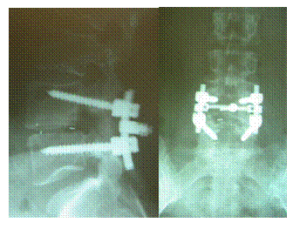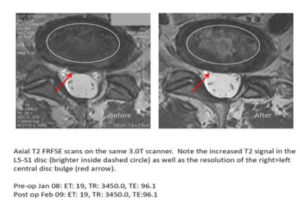Lumbar Discography is a pre-surgical procedure to identify whether one of more of the lumbar discs is a “pain generator’. It is a procedure that should only be undertaken if all other possible sources of pain have been excluded and the patient is prepared to undergone surgery. Other sources of lower back pain include lumbar facets, sacroiliac joint dysfunction, ligamental instability and trunal dystonia. At the Centeno-Schultz Clinic we are committed to evaluating all possible sources of pain prior to proceeding with discography.
Lumbar discography involves placing a needle under sterile conditions into the center of the disc at two or more levels. For example, one would place one needle at the L5/S1 level and another at the L4/5 level. Once the needles have been successfully placed, a small but increasing amount of pressure is applied to a single disc by injecting contrast through a hand held manometer. The patient is awake and asked a series of questions which include whether or not the increasing pressure recreates his or her daily pain.
A surgeon will use this information to plan the appropriate surgery. A lumbar fusion is most common, involving one or more levels where the supporting muscles are resected from the bone and the lumbar disc is removed and replaced with bone. Screws and rods are often utilized to stabilize the fusion.

Please review the MRI below of a patient who had undergone lumbar surgery without reduction in their pain. The L5/S1 disc is outlined by the dashed circle. The picture on the left is pre-procedure whereas the image on the right is 13 months after injection of patient’s own stem cells. Note that the disc has gone from dark (dehydrated) to bright(holding onto the fluid). The more the disc is able to hold onto water, the better the disc is able to absorb the forces of daily activity. Finally the red arrow on the left, points to a disc bulge which contacted the traversing nerve root. 13 months after therapy, as seen on the image on the right, the bulge and nerve root irritation is gone.

